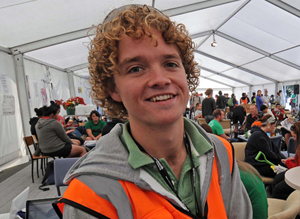Social Media/Online Community
A Beginner’s Guide to Developing Volunteer Training Videos

Do you think that creating training videos requires special expertise, lots of time, and a big budget? Think again. Perhaps nothing has evolved so rapidly in useful technology than videography: every smartphone has the capability to produce quality video; camcorders today have come down in price as their functionality has increased; and online conversations using webcams can be recorded as videos.
Patricia Wright, the director of volunteer services at Western Maryland Health System, recently began experimenting with homemade video as a tool for volunteer orientation and training. She is the first to acknowledge she’s a novice at the process, which is one of the reasons her article is so interesting. Wright explains why she began experimenting with video, the successes and not-so-successful outcomes of her first forays into videotaping, how even her first attempt upgraded her previous curriculum and ensuing discussion, and what she plans next. This Training Designs article includes links to relevant Web sites and YouTube videos to help you, too, develop your own training tools, along with a list of available video content that’s useful to almost any kind of volunteer effort.
Learning Technology Platforms: The Next Step in Training Volunteers
 Take a tour of some of the technology tools currently being used in learning design and delivery. In this issue, Sue Jones introduces a range of new learning platforms and explores the potential for organisations to further develop and enhance the ways they train volunteers. Jones also reviews some of the familiar and less familiar terms and labels emerging from this area, including social learning, e-learning and m-learning, with examples from her own and others’ experiences. And she provides comment and insight on some of her favourite learning technology articles and blogs, all designed to help readers discover more about this evolving field.
Take a tour of some of the technology tools currently being used in learning design and delivery. In this issue, Sue Jones introduces a range of new learning platforms and explores the potential for organisations to further develop and enhance the ways they train volunteers. Jones also reviews some of the familiar and less familiar terms and labels emerging from this area, including social learning, e-learning and m-learning, with examples from her own and others’ experiences. And she provides comment and insight on some of her favourite learning technology articles and blogs, all designed to help readers discover more about this evolving field.
Students vs. The Machine: Lessons Learned in the Student Community Following the Christchurch Earthquakes
 When massive earthquakes hit Christchurch, New Zealand in February 2011, university students wanted to help in the clean-up. But established first response agencies were wary of these young volunteers and too harried to work with them, so they turned them away. Sam Johnson, a student leader, would not take "no" for an answer. He turned to Facebook and put out a call to his friends. Within hours, Johnson had recruited a team of workers and borrowed enough loaned equipment to go out and simply start “mucking out.” Over the next several days, as his social network spread the word, hundreds and then thousands of students stepped forward. They called themselves the Student Volunteer Army (SVA) and eventually numbered 9,000 volunteers, earning the respect and support of the local authorities along the way. The story of Johnson and the Student Volunteer Army eventually drew headlines around the world, and attracted the attention and praise of everyone from Prince William of England to Secretary of State Hillary Clinton of the United States. Because of the media attention SVA received, the student volunteers were invited to Japan after the tsunami hit to work with a like-minded team of students. And Johnson recently returned from the World Summit for Youth Volunteering in Colombia, South America, where he presented on the role of Youth in Disaster.
When massive earthquakes hit Christchurch, New Zealand in February 2011, university students wanted to help in the clean-up. But established first response agencies were wary of these young volunteers and too harried to work with them, so they turned them away. Sam Johnson, a student leader, would not take "no" for an answer. He turned to Facebook and put out a call to his friends. Within hours, Johnson had recruited a team of workers and borrowed enough loaned equipment to go out and simply start “mucking out.” Over the next several days, as his social network spread the word, hundreds and then thousands of students stepped forward. They called themselves the Student Volunteer Army (SVA) and eventually numbered 9,000 volunteers, earning the respect and support of the local authorities along the way. The story of Johnson and the Student Volunteer Army eventually drew headlines around the world, and attracted the attention and praise of everyone from Prince William of England to Secretary of State Hillary Clinton of the United States. Because of the media attention SVA received, the student volunteers were invited to Japan after the tsunami hit to work with a like-minded team of students. And Johnson recently returned from the World Summit for Youth Volunteering in Colombia, South America, where he presented on the role of Youth in Disaster.
Today, SVA continues its work as the Christchurch area experiences aftershocks and further quakes. In this e-Volunteerism feature, Johnson shares what it’s like to be at the center of the growing emergency response momentum. He allows that he instantly had to learn volunteer management skills, describes how he successfully used social media tools, and reviews how others can connect to young people through online networks. And he explains his strong vision for “the positive change that can occur if technology at our fingertips is harnessed by Generation Y to build stronger community relationships.”
Social Media and the Gift Economy: Volunteerism in the Vanguard
The rise of social media is contributing to the return to prominence of what is called ‘the gift economy.’ As social networks and online communities grow, values such as sharing, openness and collaboration are increasingly governing our relationships and the connections between us.
According to writer Patrick Daniels, social media facilitates volunteerism and other giving activities on a grand new scale, with the assistance of recent developments in technology, critical mass usage and more visibility. Yet even as our social lives move online, Daniels argues that the field of volunteerism seems ambivalent about this increasingly social web and unsure about how to harness its potential for the benefit of volunteering programmes. This e-Volunteerism feature article attempts to untangle the connection between social media and volunteerism, and sets out a framework for understanding the kind of opportunities social media offers those in volunteer management.
Using Social Media in Your Volunteer Engagement Strategy
The Internet increasingly provides a means for nonprofits and government organizations to engage with people in their circles of influence. More and more organizations are blogging and posting YouTube videos and, more importantly, a great many organizations are asking their volunteers to blog on their behalf, to share photos of their events and to tweet about upcoming opportunities. In this way, organizations reach volunteers in the spaces where they are already comfortable and engage them around their passions. And while working to increase the volunteers’ connection with the organization, we also spread our message to all of their friends.
This Training Design is not intended to be a how-to for online volunteer engagement. Rather, it will help participants identify opportunities to use social media in their volunteer engagement strategy. After the training session, participants will be able to develop the strategy for one or two small and simple Web2.0 initiatives. Those who started the training feeling overwhelmed or apprehensive about social media will leave feeling excited about the abundant opportunities that these technologies afford.
A Look at Internet Tools for Managing Volunteers
The Internet now offers a fascinating array of tools and techniques for managing volunteers – VolunteerMatch, Facebook, blogs, Vlogs, Wikis, Twitter and many others. In this Along the Web, we take a look at these and other cutting-edge tools. After a quick research review on how volunteer groups use the Internet, we’ll look at all of these new online techniques. We’ll provide references that explain how to use them, along with some examples of volunteer programs that are already making the brave attempt.
Why Can’t We Persuade Our Field to Interact Online?
As e-Volunteerism enters its eighth year, it is clear that one of the original aims of this online journal project hasn’t been met: Namely, to get people in our field to interact more online. Most of our online readers don’t make use of the interactive publishing features that make e-Volunteerism so valuable a resource to volunteer managers. In this Keyboard Roundtable, we explore why this might be. And along the way, we look at the whole issue of online interaction by people in the volunteerism field.
Getting Their Attention: YouthNet's Innovative Approach to Engaging Young People in Volunteering
This article was compiled with the help of several YouthNet staff members. Special thanks to Tom Green, Fiona Battle, and Lucja Wisniewska.
YouthNet, the first “exclusively online charity,” was started in the UK to be a trusted source of information for all young people, supporting and enabling them to make educated life choices, participate in society and achieve their ambitions. Every month over 350,000 young adults regularly visit and use YouthNet’s TheSite.org, packed with useful, unbiased information and advice that 16-24 year-olds can trust. YouthNet also created and runs do-it.org.uk, the National Volunteering Database, which enables more than 100,000 people a month to find volunteering opportunities UK-wide.
So who could be in a better position to survey young people’s attitudes about volunteering and find out what volunteer recruitment approaches work and don’t with this age group? This article presents the process and findings of YouthNet’s creative, upbeat methodology, as well as the new recruitment campaign that resulted. It also shares more general data from the wider survey of volunteering in the UK.
